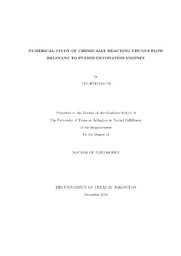
ATTENTION: The works hosted here are being migrated to a new repository that will consolidate resources, improve discoverability, and better show UTA's research impact on the global community. We will update authors as the migration progresses. Please see MavMatrix for more information.
Show simple item record
| dc.contributor.author | Yi, Tae-Hyeong | en_US |
| dc.date.accessioned | 2007-08-23T01:56:01Z | |
| dc.date.available | 2007-08-23T01:56:01Z | |
| dc.date.issued | 2007-08-23T01:56:01Z | |
| dc.date.submitted | December 2005 | en_US |
| dc.identifier.other | DISS-1198 | en_US |
| dc.identifier.uri | http://hdl.handle.net/10106/77 | |
| dc.description.abstract | A computational fluid dynamics code for two-dimensional, multi-species, laminar Navier-Stokes equations is developed to simulate a recently proposed engine concept for a pulsed detonation based propulsion system and to investigate the feasibility of the engine of the concept.The governing equations that include transport phenomena such as viscosity, thermal conduction and diffusion are coupled with chemical reactions. The gas is assumed to be thermally perfect and in chemically non-equilibrium. The stiffness due to coupling the fluid dynamics and the chemical kinetics is properly taken care of by using a time-operator splitting method and a variable coefficient ordinary differential equation solver. A second-order Roe scheme with a minmod limiter is explicitly used for space descretization, while a second-order, two-step Runge-Kutta method is used for time descretization. In space integration, a finite volume method and a cell-centered scheme are employed. The first-order derivatives in the equations of transport properties are discretized by a central differencing with Green's theorem. Detailed chemistry is involved in this study. Two chemical reaction mechanisms are extracted from GRI-Mech, which are forty elementary reactions with thirteen species for a hydrogen-air mixture and twenty-seven reactions with eight species for a hydrogen-oxygen mixture. The code is ported to a high-performance parallel machine with Message-Passing Interface. Code validation is performed with chemical kinetic modeling for a stoichiometric hydrogen-air mixture, an one-dimensional detonation tube, a two-dimensional, inviscid flow over a wedge and a viscous flow over a flat plate. Detonation is initiated using a numerically simulated arc-ignition or shock-induced ignition system. Various freestream conditions are utilized to study the propagation of the detonation in the proposed concept of the engine. Investigation of the detonation propagation is performed for a pulsed detonation rocket and a supersonic combustion chamber. For a pulsed detonation rocket case, the detonation tube is embedded in a mixing chamber where an initiator is added to the main detonation chamber. Propagating detonation waves in a supersonic combustion chamber is investigated for one- and two-dimensional cases. The detonation initiated by an arc and a shock wave is studied in the inviscid and viscous flow, respectively. Various features including a detonation-shock interaction, a detonation diffraction, a base flow and a vortex are observed. | en_US |
| dc.description.sponsorship | Wilson, Donald R. | en_US |
| dc.language.iso | EN | en_US |
| dc.publisher | Aerospace Engineering | en_US |
| dc.title | Numerical Study Of Chemically Reacting Viscous Flow Relevant To Pulsed Detonation Engines | en_US |
| dc.type | Ph.D. | en_US |
| dc.contributor.committeeChair | Wilson, Donald R. | en_US |
| dc.degree.department | Aerospace Engineering | en_US |
| dc.degree.discipline | Aerospace Engineering | en_US |
| dc.degree.grantor | University of Texas at Arlington | en_US |
| dc.degree.level | doctoral | en_US |
| dc.degree.name | Ph.D. | en_US |
| dc.identifier.externalLink | https://www.uta.edu/ra/real/editprofile.php?onlyview=1&pid=268 | |
| dc.identifier.externalLinkDescription | Link to Research Profiles | |
Files in this item
- Name:
- umi-uta-1198.pdf
- Size:
- 7.034Mb
- Format:
- PDF
This item appears in the following Collection(s)
Show simple item record


